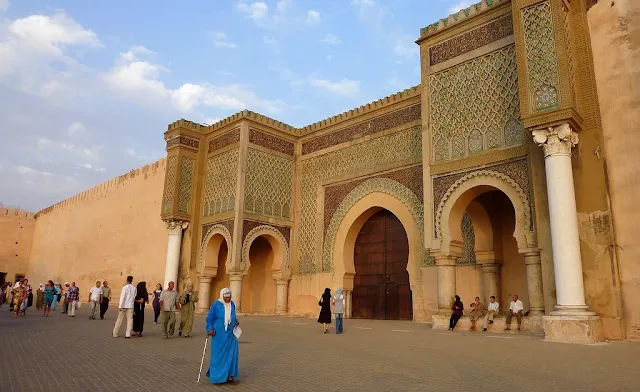Morocco History

Discover Morocco’s Rich History
(toc)
Morocco, a land of vibrant culture, breathtaking landscapes, and deep historical roots, has fascinated travelers for centuries. From ancient Berber kingdoms to Roman invasions, Islamic dynasties, and European colonialism, Morocco’s history is a captivating blend of influences that shaped its unique identity.
For foreign tourists, understanding Morocco’s past enhances the travel experience, offering deeper insights into its architecture, traditions, and people. In this article, we’ll explore Morocco’s fascinating history, highlighting key periods and must-visit historical sites.
1. Ancient Morocco: The Berbers and Early Civilizations
Long before Morocco became a crossroads of cultures, it was home to the Berbers (Amazigh), the indigenous people of North Africa. The Berbers established early settlements and trade routes, leaving behind cave paintings and ancient ruins.
 |
| Credit: Pixabay |
What Travelers See Today: The Berber influence remains
visible throughout Morocco. In the Atlas Mountains, traditional Berber villages
showcase ancient architectural styles, while Berber carpets, jewelry, and
handicrafts sold in souks carry symbols and patterns thousands of years old.
The Tamazight language, spoken by millions of Moroccans, connects modern
visitors to this ancient heritage.
Key Historical Sites:
- Volubilis: A UNESCO World Heritage Site, this well-preserved Roman city showcases mosaics, arches, and columns from the 3rd century BC.
- Lixus: Near Larache, this ancient Phoenician and Roman city offers ruins overlooking the Loukkos River.
2. Roman and Islamic Influence in Morocco
Roman Morocco (1st–5th Century AD)
The Romans conquered parts of Morocco, naming the region Mauretania Tingitana. Volubilis thrived as a Roman administrative center, exporting olive oil and grain.
 |
| Credit: Pixabay |
The Arrival of Islam (7th Century Onwards)
In 681 AD, Arab general Uqba ibn Nafi brought Islam to Morocco. The Idrisid Dynasty (789–974) founded by Idris I established Fes as a spiritual and intellectual hub.
Key Historical Sites:
- Fes el-Bali: The world’s oldest university, Al Quaraouiyine, is located here.
- Chellah (Rabat): A medieval Islamic necropolis with Roman ruins.
3. The Golden Age: Almoravids, Almohads, and Merinids
The Almoravid Empire (1040–1147)
Founded by Yusuf ibn Tashfin, the Almoravids unified Morocco and Spain (Al-Andalus), building Koutoubia Mosque (Marrakech).
 |
| Credit: Unsplash |
The Almohad Caliphate (1147–1269)
Under Abd al-Mu’min, the Almohads constructed the Hassan Tower (Rabat) and expanded Islamic architecture.
The Merinid Dynasty (1244–1465)
The Merinids revived Fes, building medersas (Islamic schools) like Bou Inania.
Key Historical Sites:
- Koutoubia Mosque (Marrakech): A symbol of Almohad architecture.
- Bou Inania Medersa (Fes): A masterpiece of Merinid craftsmanship.
4. The Rise of the Saadi and Alaouite Dynasties
The Saadi Dynasty (1549–1659)
The Saadians expelled Portuguese invaders and built the El Badi Palace and Saadian Tombs in Marrakech.
The Alaouite Dynasty (1666–Present)
The current ruling dynasty, the Alaouites, strengthened Morocco’s sovereignty. Moulay Ismail made Meknes his imperial capital, while Mohammed V led Morocco to independence in 1956.
Key Historical Sites:
- Saadian Tombs (Marrakech): Lavish mausoleums from the 16th century.
- Meknes: Known for its grand gates and Heri es-Souani granaries.
 |
| Credit: flickr |
5. European Colonialism and Independence
French and Spanish Protectorates (1912–1956)
Morocco was divided between France (central Morocco) and Spain (north and south). Nationalist movements, led by Mohammed V and Istiqlal Party, fought for freedom.
Independence (1956) and Modern Morocco
After gaining independence, Morocco became a constitutional monarchy. Today, it blends tradition with modernity, attracting millions of tourists yearly.
Key Historical Sites:
- Rabat’s Mohammed VI Museum: Showcases modern Moroccan history.
- Tangier’s American Legation Museum: Highlights Morocco-US relations.
 |
| Credit: Pixabay |
6. Must-Visit Historical Cities for Tourists
- Marrakech – The Red City with Jemaa el-Fnaa, Bahia Palace, and Koutoubia Mosque.
- Fes – Morocco’s spiritual heart with ancient medersas and tanneries.
- Chefchaouen – The Blue Pearl, founded in 1471 as a Moorish fortress.
- Essaouira – A Portuguese-influenced coastal town with UNESCO-listed medina.
- Casablanca – Home to the grand Hassan II Mosque, blending modern and Islamic architecture.
 |
| Credit: Unsplash |
Conclusion:
Why Morocco’s History Matters for Tourists?
Morocco’s history is a living tapestry, visible in its medinas, mosques, and monuments. By exploring its past, travelers gain a deeper appreciation for its culture, art, and traditions.
Whether you’re wandering through Roman ruins, Islamic palaces, or colonial-era cities, Morocco offers an unforgettable journey through time.
Plan your trip today and step into Morocco’s extraordinary
history!


%20copy.webp)



Comments